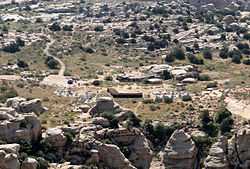Dana Biosphere Reserve
| Dana Biosphere Reserve | |
|---|---|
|
Dana Reserve landscape | |
| Nearest city | Tafilah |
| Established | 1989 |
| Governing body | Royal Society for the Conservation of Nature |



Dana Biosphere Reserve is Jordan's largest nature reserve,[1] located in south-central Jordan. Dana Biosphere Reserve was founded in 1989[1] in the area in and around the Dana village and Wadi Dana comprising 308 square kilometres (119 sq mi).[2]
Human presence
The people of the Ata'ta (or Al Atata) tribe are the native inhabitants[2] of Dana Biosphere Reserve. Their history in Dana dates 400 years, but their original settlement in the area dates more than 6000 years.[2] Besides the presence of the Ata'ta people, archeological discoveries suggest Palaeolithic, Egyptian, Nabataean, and Roman settlement in Dana.[2]
Accommodations
Visitors to Dana Nature Reserve and Dana village can stay at Dana Cooperative Hotel and other accommodations.[2]
Geography
Dana Biosphere Reserve drops from an altitude of 1,500 metres (4,900 ft) on the Qadisiyah plateau to the low-lying desert area of Wadi Araba.[1] The varied geology of Dana contains limestone, sandstone, and granite. The area of Wadi Dana features wind-cut sandstone cliffs. Dana is the only nature reserve in Jordan that crosses four bio-geographical zones; Mediterannean, Irano-Turanian, Saharo-Arabian, and Sudanian penatration.[1]
Flora and fauna
The diverse environment of Dana is home to 703 plant species, 215 species of birds, and 38 species of mammals.[2]
Plants
Dana is the most diverse area of plant life in the country, consisting of numerous vegetation types including: Phoenician Juniper, evergreen oak, sand dunes, acacia, and rocky sudanian.[1] Dana is the southernmost area in the world to host the Mediterranean Cypress, Cupressus sempervirens. Of the hundreds of plants species inhabiting Dana, three can be found nowhere else in the world. Many plants, especially trees and shrubs, grow in the highlands of the nature reserve.[1]
Endangered species
The threatened Nubian Ibex, Syrian Serin, Caracal, and Lesser Kestrel are natives of Wadi Dana and plans to save the species were put forth by Global Environment Fund in 1994. Additionally, the largest breeding colony of the Syrian Serin is in Dana Nature Reserve. Threats to the animals include hunting.[1]
See also
- Mujib Nature Reserve
- Azraq Wetland Reserve
- List of nature reserves in Jordan
References
External links
| Wikimedia Commons has media related to Dana Biosphere Reserve. |
- Dana Biosphere Reserve
- Dana Community Cooperative
- The Royal Society for the Conservation of Nature
- Dana Cooperative Hotel
| ||||||||||
